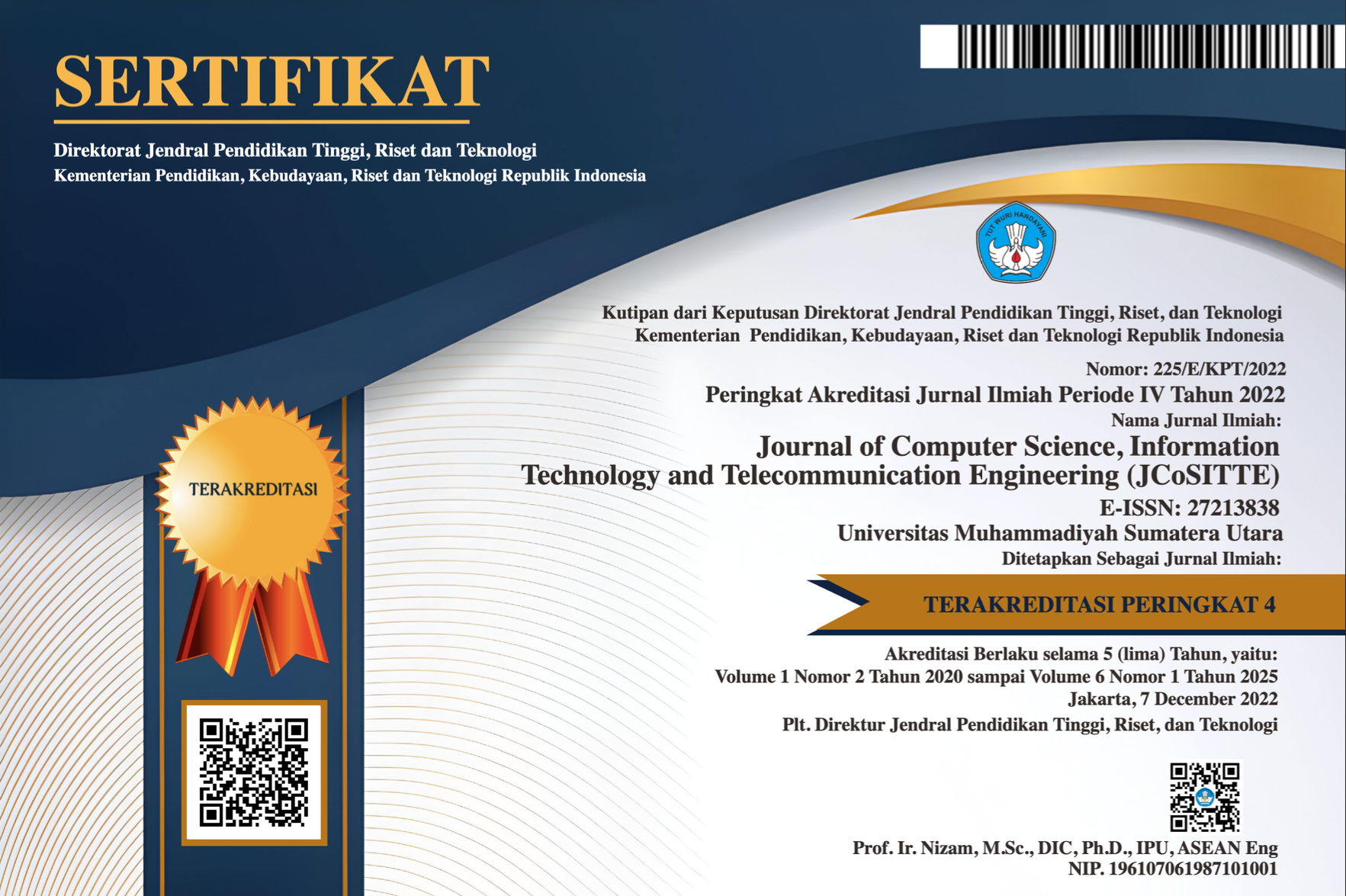Integration of Artificial Intelligence in Management Information Systems to Improve the Effectiveness of Strategic Decision-Making in the Digital Era
Abstract
Keywords
Full Text:
PDFReferences
Adadi, A., & Berrada, M. (2018). Peeking inside the black-box: A survey on explainable artificial intelligence (XAI). IEEE Access, 6, 52138–52160. https://doi.org/10.1109/ACCESS.2018.2870052
Agrawal, A., Gans, J., & Goldfarb, A. (2018). Prediction Machines: The Simple Economics of Artificial Intelligence. Harvard Business Review Press.
Barocas, S., Hardt, M., & Narayanan, A. (2023). Fairness and Machine Learning: Limitations and Opportunities.
Borges, A. F., Laurindo, F. J. B., Spínola, M. de M., Gonçalves, R. F., & Mattos, C. A. (2021). The strategic use of artificial intelligence in the digital era: Systematic literature review and future research directions. International Journal of Information Management, 57, 102225. https://doi.org/10.1016/j.ijinfomgt.2020.102225
Brynjolfsson, E., & McAfee, A. (2019). The second machine age: Work, progress, and prosperity in a time of brilliant technologies. W. W. Norton & Company.
Bughin, J., Hazan, E., Ramaswamy, S., Chui, M., Allas, T., Dahlström, P., & Trench, M. (2020). The age of AI: Artificial intelligence and the future of humanity. McKinsey Global Institute.
Chandra, S., Verma, S., Lim, W. M., Kumar, S., & Donthu, N. (2022). Personalization in personalized marketing: Trends and ways forward. Psychology & Marketing, 39(8), 1529–1562. https://doi.org/10.1002/mar.21670
Chen, H., Chiang, R. H. L., & Storey, V. C. (2021). Business intelligence and analytics: From big data to big impact. MIS Quarterly, 45(4), 1836–1882. https://doi.org/10.25300/MISQ/2021/16474
Company, M. &. (2024). The state of AI in Indonesia: Digital transformation accelerating. McKinsey Global Institute.
Creswell, J. W., & Plano Clark, V. L. (2017). Designing and conducting mixed methods research (3rd ed.). Sage Publications.
Davenport, T. H., & Ronanki, R. (2018). Artificial intelligence for the real world. Harvard Business Review, 96(1), 108–116.
Duan, Y., Edwards, J. S., & Dwivedi, Y. K. (2019). Artificial intelligence for decision making in the era of Big Data--evolution, challenges and research agenda. International Journal of Information Management, 48, 63–71. https://doi.org/10.1016/j.ijinfomgt.2019.01.021
Fountaine, T., McCarthy, B., & Saleh, T. (2019). Building the AI-powered organization. Harvard Business Review, 97(4), 62–73.
Haenlein, M., & Kaplan, A. (2019). A brief history of artificial intelligence: On the past, present, and future of artificial intelligence. California Management Review, 61(4), 5–14. https://doi.org/10.1177/0008125619864925
Hair, J. F., Risher, J. J., Sarstedt, M., & Ringle, C. M. (2019). When to use and how to report the results of PLS-SEM. In European Business Review (Vol. 31, Issue 2). https://doi.org/10.1108/EBR-11-2018-0203
Institute, M. G. (2021). The state of AI in 2021. McKinsey & Company.
Laudon, K. C., & Laudon, J. P. (2020). Management information systems: Managing the digital firm (16th ed.).
Liu, Y., & Chen, X. (2021). Exploring the relationship between customer experience and satisfaction in e-commerce platforms. Journal of Retailing and Consumer Services, 60, 102510.
Marr, B. (2020). Artificial intelligence in practice: How 50 successful companies used AI and machine learning to solve problems. John Wiley & Sons.
Myers, M. D., & Newman, M. (2021). The qualitative interview in IS research: Examining the craft. Information and Organization, 17(1), 2–26. https://doi.org/10.1016/j.infoandorg.2006.11.001
Provost, F., & Fawcett, T. (2023). Data Science for Business: What You Need to Know about Data Mining and Data-Analytic Thinking. O’Reilly Media, Inc.
Ransbotham, S., Kiron, D., Gerbert, P., & Reeves, M. (2020). The future of work in technology. MIT Sloan Management Review, 61(4), 1–4.
Russell, S., & Norvig, P. (2021). Artificial Intelligence: A Modern Approach, Global Edition, 4ed. Pearson Education.
Shmueli, G., Sarstedt, M., Hair, J. F., Cheah, J.-H., Ting, H.,
Vaithilingam, S., & Ringle, C. M. (2019). Predictive model assessment in PLS-SEM: guidelines for using PLSpredict. European Journal of Marketing, 53(11), 2322–2347. https://doi.org/10.1108/EJM-02-2019-0189
Sivarajah, U., Kamal, M. M., Irani, Z., & Weerakkody, V. (2016). Critical analysis of Big Data challenges and analytical methods. Journal of Business Research, August. https://doi.org/10.1016/j.jbusres.2016.08.001
Teece, D. J. (2018). Business models and dynamic capabilities. Long Range Planning, 51(1), 40–49. https://doi.org/10.1016/j.lrp.2017.06.007
Teece, D. J., Pisano, G., & Shuen, A. (1997). Dynamic capabilities and strategic management. Strategic Management Journal, 18(7), 509–533. https://doi.org/10.1002/(SICI)1097-0266(199708)18:7<509::AID-SMJ882>3.0.CO;2-Z
Venkatesh, V., Thong, J. Y. L., & Xu, X. (2020). Unified theory of acceptance and use of technology: A synthesis and the road ahead. Journal of the Association for Information Systems, 21(2), 478–509. https://doi.org/10.17705/1jais.00611
Vial, G. (2019). Understanding digital transformation: A review and a research agenda. Journal of Strategic Information Systems, 28(2), 118–144. https://doi.org/10.1016/j.jsis.2019.01.003
Warner, K. S. R., & Wäger, M. (2019). Building dynamic capabilities for digital transformation: An ongoing process of strategic renewal. Long Range Planning, 52(3), 326–349. https://doi.org/10.1016/j.lrp.2018.12.001
Winfield, A. F. T., Jirotka, M., & Winfield, A. F. T. (2018). Ethical governance is essential to building trust in robotics and artificial intelligence systems Subject Areas : Author for correspondence : Philosophical Transactions A, 376.
DOI: https://doi.org/10.30596/jcositte.v6i2.26051
Refbacks
- There are currently no refbacks.





.png)

